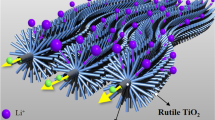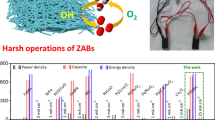Abstract
Aqueous Zn-ion batteries (ZIBs) are very attractive owing to their high safety and low cost. Among various cathode materials, organic materials-based electrodes incorporating various redox functional groups have gained significant attention in the field of ZIBs due to their benefits of a tunable structural design, facility, eco-friendly, and possibility of multivalent energy storage. Herein, we demonstrate the nanostructured organic active materials deposited onto the CNT networks (HyPT@CNT) for flexible ZIBs. This HyPT nanorods were obtained reassemblying the herringbone structured 3,4,9,10-tetracarboxylic dianhydride through a hydrothermal process in the presence of acid. These HyPT@CNT hybrids were electronically conductive and redox active, as well as could be fabricated into a flexible electrode achieving flexibility from mechanical integrity of robust networked structure. The as-fabricated flexible ZIBs delivered the high capacity of 100 Ah g−1 at a current density of 0.1 A g−1 and long-term cycling performance exceeding 5000 cycles. Consequently, these electrochemical performances are associated with the redox reactivity of carbonyl groups as verified by spectroscopic and electrochemical characterizations and the hybridization of HyPT nanorods with CNT networks.





Similar content being viewed by others
Data availability
The data that support the findings of this study are available from the corresponding author upon reasonable request.
References
Dunn B, Kamath H, Tarascon J-M (2011) Electrical energy storage for the grid: a battery of choices. Science 334:928–935. https://doi.org/10.1126/science.1212741
Donghyeok S, Won-Gwang L, Jinwoo L (2023) A short review of the recent developments in functional separators for lithium-sulfur batteries. Korean J Chem Eng 40:473–487. https://doi.org/10.1007/s11814-022-1372-0
Xie J, Zhang Q (2019) Recent progress in multivalent metal (Mg, Zn, Ca, and Al) and metal-ion rechargeable batteries with organic materials as promising electrodes. Small 15:1805061. https://doi.org/10.1002/smll.201805061
Xiong P, Zhang Y, Zhang J, Baek SH, Zeng L, Yao Y, Park HS (2022) Recent progress of artificial interfacial layers in aqueous Zn metal batteries. EnergyChem 4:100076. https://doi.org/10.1016/j.enchem.2022.100076
Xiong P et al (2022) Galvanically replaced artificial interfacial layer for highly reversible zinc metal anodes. Appl Phys Rev 9:011401. https://doi.org/10.1063/5.0074327
Xiong P et al (2023) Charge-transfer complex-based artificial layers for stable and efficient Zn metal anodes. ACS Energy Lett 8:2718–2727. https://doi.org/10.1021/acsenergylett.3c00534
Xiong P et al (2023) Zn-ion transporting, in situ formed robust solid electrolyte interphase for stable zinc metal anodes over a wide temperature range. ACS Energy Lett 8:1613–1625. https://doi.org/10.1021/acsenergylett.3c00154
Zhou L-F et al (2022) A strategy for anode modification for future zinc-based battery application. Mater Horiz 9:2722–2751. https://doi.org/10.1039/d2mh00973k
Fang G, Zhou J, Pan A, Liang S (2018) Recent advances in aqueous zinc-ion batteries. ACS Energy Lett 3:2480–2501. https://doi.org/10.1021/acsenergylett.8b01426
Shin KH, Ji D, Park JM, Joe YS, Park HS, Kim J (2023) Structural composite hydrogel electrolytes for flexible and durable Zn metal batteries. Adv Funct Mater. https://doi.org/10.1002/adfm.202309048
Mo F, Guo B, Ling W et al (2022) Recent progress and challenges of flexible Zn-based batteries with polymer electrolyte. Batteries 8:59–75. https://doi.org/10.3390/batteries8060059
Yan Y, Zhou Y, Li Y, Liu Y (2023) The new focus of energy storage: flexible wearable supercapacitors. Carbon Lett 33:1461–1483. https://doi.org/10.1007/s42823-023-00554-8
Gao J et al (2022) A flexible and stable zinc-ion hybrid capacitor with polysaccharide-reinforced cross-linked hydrogel electrolyte and binder-free carbon cathode. J Mater Chem A 10:24639–24648. https://doi.org/10.1039/d2ta06985g
Xu W, Wang Y (2019) Recent progress on zinc-ion rechargeable batteries. Nano-Micro Lett 11:90–119. https://doi.org/10.1007/s40820-019-0322-9
Pang Q et al (2018) H2V3O8 nanowire/graphene electrodes for aqueous rechargeable zinc ion batteries with high rate capability and large capacity. Adv Energy Mater 8:1800144. https://doi.org/10.1002/aenm.201800144
Liu X, Shen X, Chen T, Xu Q (2022) The spinel MnFe2O4 grown in biomass-derived porous carbons materials for high-performance cathode materials of aqueous zinc-ion batteries. J Alloy Compd 904:164002. https://doi.org/10.1016/j.jallcom.2022.164002
Atta MM et al (2023) Nitrogen plasma synthesis of flexible supercapacitors based on reduced graphene oxide/aloe vera/carbon nanotubes nanocomposite. Carbon Lett 33:1639–1648. https://doi.org/10.1007/s42823-023-00548-6
Rajeshkumar L, Ramesh M, Bhuvaneswari V, Balaji D (2023) Carbon nano-materials (CNMs) derived from biomass for energy storage applications: a review. Carbon Lett 33:661–690. https://doi.org/10.1007/s42823-023-00478-3
Amy Aynee C, Archina B, Abdul AAR, Shaliza I (2022) Recent advances on the coconut shell derived carbonaceous material for the removal of recalcitrant pollutants: a review. Korean J Chem Eng 39:2571–2593. https://doi.org/10.1007/s11814-022-1201-5
Ehsan K, Hamidreza S (2022) Recent advances in properties and applications of nanoporous materials and porous carbons. Carbon Lett 32:1645–1669. https://doi.org/10.1007/s42823-022-00395-x
Sun W, Wang F et al (2017) Zn/MnO2 battery chemistry with H+ and Zn2+ coinsertion. J Am Chem Soc 139:9775–9778. https://doi.org/10.1021/jacs.7b04471
Pan H et al (2016) Reversible aqueous zinc/manganese oxide energy storage from conversion reactions. Nat Energy 1(5):16039. https://doi.org/10.1038/nenergy.2016.39
Wang L, Huang K-W, Chen J, Zheng J (2019) Ultralong cycle stability of aqueous zinc-ion batteries with zinc vanadium oxide cathodes. Sci Adv 5(10):4279. https://doi.org/10.1126/sciadv.aax4279
Ding K et al (2023) Recent advances of Na3V2(PO4)3 as cathode for rechargeable zinc-based batteries. Carbon Lett 33:989–1012. https://doi.org/10.1007/s42823-023-00500-8
Yeon JS, Kim WI, Kim HJ, Jang G, Park JM, Park JH, Li Y, Park HS (2023) Accordion-like polyoxometalate hybrid architectures for capacity-dense and flexible Zn-Ion battery cathodes. Energy Storage Mater 63:102944. https://doi.org/10.1016/j.ensm.2023.102944
Patil SJ et al (2022) Ultra-stable flexible Zn-ion capacitor with pseudocapacitive 2D layered niobium oxyphosphides. Energy Storage Mater 45:1040–1051. https://doi.org/10.1016/j.ensm.2021.10.040
Zampardi G, Mantia FL (2020) Prussian blue analogues as aqueous Zn-ion batteries electrodes: current challenges and future perspectives. Curr Opin Electrochem 21:84–92. https://doi.org/10.1016/j.coelec.2020.01.014
Yang Y et al (2022) Prussian blue and its analogues as cathode materials for Na-, K-, Mg-, Ca- Zn- and Al-ion batteries. Nano Energy 99:107424. https://doi.org/10.1016/j.nanoen.2022.107424
Pu X et al (2020) High-performance aqueous zinc-ion batteries realized by MOF materials. Nano-Micro Lett 12:152. https://doi.org/10.1007/s40820-020-00487-1
Jung M, Gund GS, Dunn B, Park HS (2020) Nanorod-like organic active materials directly grown on the carbon cloth for aqueous zn-ion batteries. Energy Fuels. https://doi.org/10.1021/acs.energyfuels.3c00816
Gao Y, Yin J, Xu X, Cheng Y (2022) Pseudocapacitive storage in cathode materials of aqueous zinc ion batteries toward high power and energy density. J Mater Chem A 10:9773. https://doi.org/10.1039/d2ta01014c
Zheng S, Wang Q, Hou Y, Li L, Tao Z (2021) Recent progress and strategies toward high performance zinc-organic batteries. J Energy Chem 63:87–112. https://doi.org/10.1016/j.jechem.2021.07.027
Son EJ, Kim JH, Kim K, Park CB (2016) Quinone and its derivatives for energy harvesting and storage materials. J Mater Chem A 4:11179. https://doi.org/10.1039/c6ta03123d
Peng et al (2019) Molecular design strategies for electrochemical behavior of aromatic carbonyl compounds in organic and aqueous electrolytes. Adv Sci 6:1900431. https://doi.org/10.1002/advs.201900431
Shea JJ, Luo C (2020) Organic electrode materials for metal ion batteries. ACS Appl Mater Interfaces 12:5361–5380. https://doi.org/10.1021/acsami.9b20384
Huang T, Long M, Xiao J, Liu H, Wang G (2021) Recent research on emerging organic electrode materials for energy storage. Energy Mater 1:100009. https://doi.org/10.20517/energymater.2021.09
Gannett CN et al (2021) Organic electrode materials for fast-rate, high-power battery applications. Mater Reports: Energy 1:100008. https://doi.org/10.1016/j.matre.2021.01.003
Lian X et al (2020) Alkali metal storage mechanism in organic semiconductor of perylene-3,4,9,10-tetracarboxylicdianhydride. Appl Surf Sci 524:146396. https://doi.org/10.1016/j.apsusc.2020.146396
Mura M et al (2010) Experimental and theoretical analysis of H-bonded supramolecular assemblies of PTCDA molecules. Phys Rev B 81:195412. https://doi.org/10.1103/PhysRevB.81.195412
Guo R et al (2019) Surface passivation of black phosphorus via van der Waals stacked PTCDA. Appl Surf Sci 496:143688. https://doi.org/10.1016/j.apsusc.2019.143688
Belanger RL et al (2019) Diffusion control of organic cathode materials in lithium metal battery. Sci Rep 9:1213. https://doi.org/10.1038/s41598-019-38728-y
Sowmiyha S et al (2018) Self-assembly of water soluble perylene tetracarboxylic acid with metal cations: selective fluorescence sensing of Cu2+ and Pb2+ ions in paper strips, zebrafish and yeast. J Lumin 203:42–49. https://doi.org/10.1016/j.jlumin.2018.06.026
Chen Y et al (2015) Organic electrode for non-aqueous potassium-ion batteries. Nano Energy 18:205–211. https://doi.org/10.1016/j.nanoen.2015.10.015
Calandra P, Fazio E, Neri F, Leone N, Liveri VT (2014) Sensitization of nanocrystalline TiO2 with 3,4,9,10-perylenetetracarboxylic acid. J Nanopart Res 16:2495. https://doi.org/10.1007/s11051-014-2495-y
Raj MR et al (2020) Perylenedianhydride-based polyimides as organic cathodes for rechargeable lithium and sodium batteries. ACS Appl Energy Mater 3:240–252. https://doi.org/10.1021/acsaem.9b01419
Liu Y et al (2018) Activating aromatic rings as Na-ion storage sites to achieve high capacity. Chem 4:2463–2478. https://doi.org/10.1016/j.chempr.2018.08.015
Wnag C, Tang W, Yao Z, Cao B, Fan C (2019) Potassium perylene-tetracarboxylate with two-electron redox behaviors as a highly stable organic anode for K-ion batteries. Chem Commun 55:1801. https://doi.org/10.1039/c8cc09596e
Cui D, Tian D, Chen S, Yuan L (2016) Graphene wrapped 3,4,9,10-perylenetetracarboxylic dianhydride as a high performance organic cathode for lithium ion batteries. J Mater Chem A 4:9177. https://doi.org/10.1039/c6ta02880b
Christina LC, Gunlazuardi J, Zulys A (2019) Synthesis and characterization of lanthanide metal-organic framework with perylene 3,4,9,10-tetracarboxylate ligand. 2020 IOP Conf Ser Mater Sci Eng. 902:012046. https://doi.org/10.1088/1757-899X/902/1/012046
Alfaify S et al (2016) Optical properties of nano-rods PTCDA thin films: an important material for optoelectronic applications. Org Opto-Elect 2(1):1–14
Konarev DV et al (2021) Structure, optical and magnetic properties of radical anion, dianion salts and coordination complexes of organic dye 3,4:9,10-perylenetetracarboxylic dianhydride (PTCDA). Dyes Pigm 184:108769. https://doi.org/10.1016/j.dyepig.2020.108769
Tong Z et al (2020) Tailored redox kinetics, electronic structures and electrode/electrolyte interfaces for fast and high energy-density potassium-organic battery. Adv Funct Mater 30:1907656. https://doi.org/10.1002/adfm.201907656
Shulitski BG, Filippov VV (2009) IR absorption anisotropy in perylene-3,4,9,10-tetracarboxylic acid dianhydride. J Appl Spectrosc 76(5):660. https://doi.org/10.1007/s10812-009-9254-3
Mo Z et al (2018) Electrochemical recognition for tryptophan enantiomers based on 3,4,9,10-perylenetetracarboxylic acid–chitosan composite film. J Solid State Electrochem 22:2405–2412. https://doi.org/10.1007/s10008-018-3960-9
Zheng R, Zhang M, Sun X, Chen R, Sun X (2019) Perylene-3,4,9,10-tetracarboxylic acid accelerated light-driven water oxidation on ultrathin indium oxide porous sheets. Appl Catal B 254:667–676. https://doi.org/10.1016/j.apcatb.2019.05.003
Xu M et al (2021) Graphene composite 3,4,9,10-perylenetetracarboxylic sodium salts with a honeycomb structure as a high performance anode material for lithium ion batteries. Nanoscale Adv 3:4561. https://doi.org/10.1039/d1na00366f
Sayyad AS, Balakrishnan K, Ajayan PM (2011) Chemical reaction mediated self-assembly of PTCDA into nanofibers. Nanoscale 3:3605. https://doi.org/10.1039/c1nr10579e
Zhao RR, Cao YL, Ai XP, Yang HX (2013) Reversible Li and Na storage behaviors of perylenetetracarboxylates as organic anodes for Li- and Na-ion batteries. J Electroanal Chem 688:93–97. https://doi.org/10.1016/j.jelechem.2012.07.019
Guo Y et al (2022) Perylenetetracarboxylic acid nanosheets with internal electric fields and anisotropic charge migration for photocatalytic hydrogen evolution. Nat Commun 13:2067. https://doi.org/10.1038/s41467-022-29826-z
Wu H, Hu T, Chang S, Li L, Yuan W (2021) Sodium-based dual-ion battery based on the organic anode and ionic liquid electrolyte. ACS Appl Mater Interfaces 13:44254–44265. https://doi.org/10.1021/acsami.1c10836
Karlsmo M, Bouchal R, Johansson P (2021) High-performant all-organic aqueous sodium-ion batteries enabled by PTCDA electrodes and a hybrid Na/Mg electrolyte. Angew Chem Int Ed 60:24709–24715. https://doi.org/10.1002/anie.202111620
Yu F, Wang Y, Liu Y, Hui H-Y, Wang F-X, Li J-F, Wang Q (2022) An aqueous rechargeable zinc-ion battery on basis of an organic pigment. Rare Met 41(7):2230–2236. https://doi.org/10.1007/s12598-021-01941-8
Han Y et al (2015) Preparation, optical and electrical properties of PTCDA nanostructures. Nanoscale 7:17116–17121. https://doi.org/10.1039/c5nr04738b
Rodríguez-Pérez IA et al (2017) Mg-ion battery electrode: an organic solid’s herringbone structure squeezed upon Mg-ion insertion. J Am Chem Soc 139:13031–13037. https://doi.org/10.1021/jacs.7b06313
Fan L, Ma R, Wang J, Yang H, Lu B (2018) An ultrafast and highly stable potassium-organic battery. Adv Mater 30:1805486. https://doi.org/10.1002/adma.201805486
Luo W, Allen M, Raju V, Ji X (2014) An organic pigment as a high-performance cathode for sodium-ion batteries. Adv Energy Mater 4:1400554. https://doi.org/10.1002/aenm.201400554
Gund GS et al (2019) MXene/polymer hybrid materials for flexible AC-filtering electrochemical capacitors. Joule 3:164–176. https://doi.org/10.1016/j.joule.2018.10.017
Acknowledgements
This work is financially supported by the Technology Innovation Program (20004958, Development of Ultrahigh Performance Supercapacitor and High Power Module) funded by the Ministry of Trade, Industry, and Energy (MOTIE).
Funding
Korea Evaluation Institute of Industrial Technology, 20004958, Ho Seok Park.
Author information
Authors and Affiliations
Corresponding author
Ethics declarations
Conflict of interest
The authors declare no conflict of interest.
Additional information
Publisher's Note
Springer Nature remains neutral with regard to jurisdictional claims in published maps and institutional affiliations.
Supplementary Information
Below is the link to the electronic supplementary material.
Rights and permissions
Springer Nature or its licensor (e.g. a society or other partner) holds exclusive rights to this article under a publishing agreement with the author(s) or other rightsholder(s); author self-archiving of the accepted manuscript version of this article is solely governed by the terms of such publishing agreement and applicable law.
About this article
Cite this article
Choi, M.S., Jung, M.K., Rana, H.H. et al. Organic nanorods deposited onto the carbon nanotube networks for flexible zinc-ion batteries. Carbon Lett. 34, 25–39 (2024). https://doi.org/10.1007/s42823-023-00658-1
Received:
Revised:
Accepted:
Published:
Issue Date:
DOI: https://doi.org/10.1007/s42823-023-00658-1




